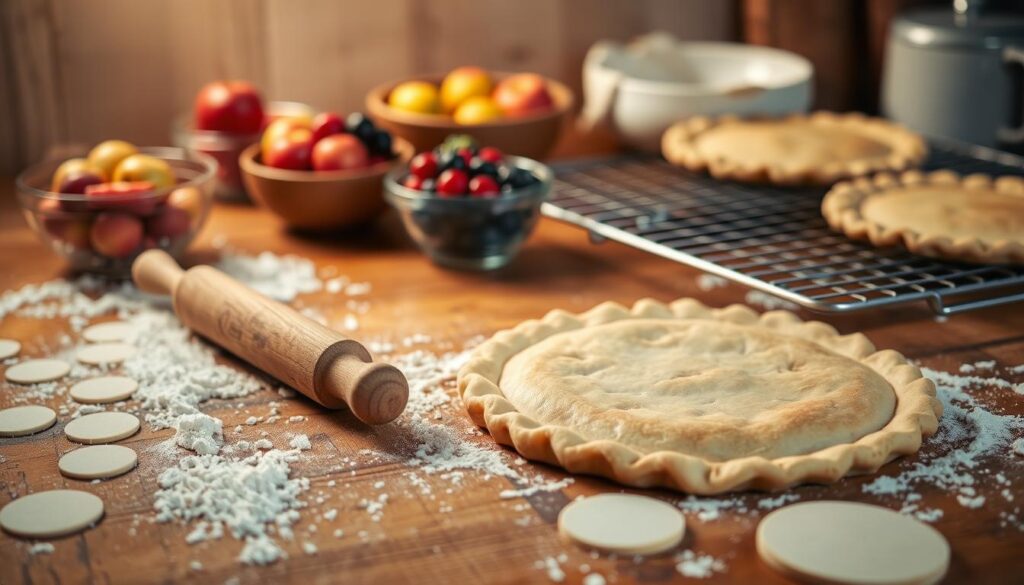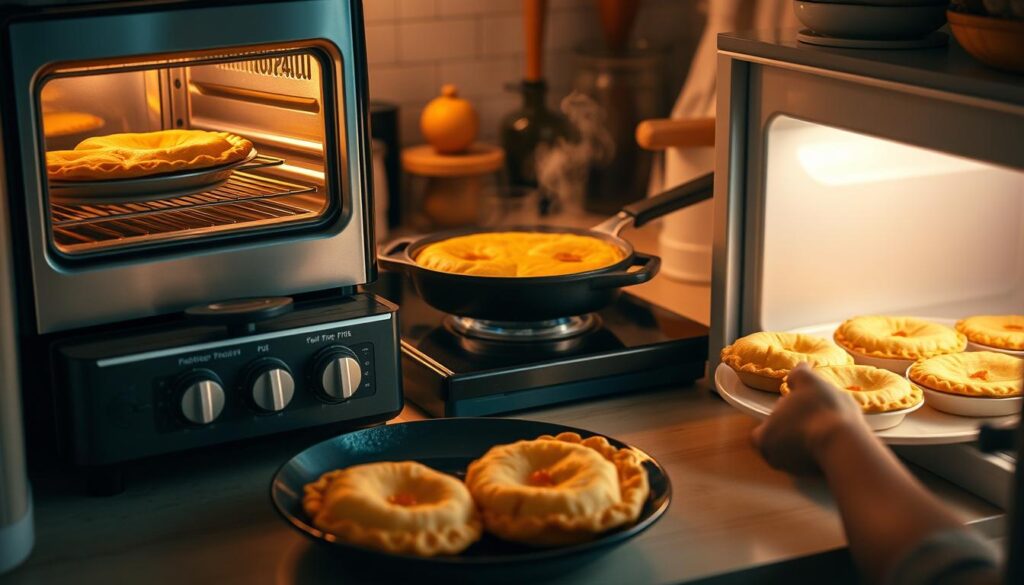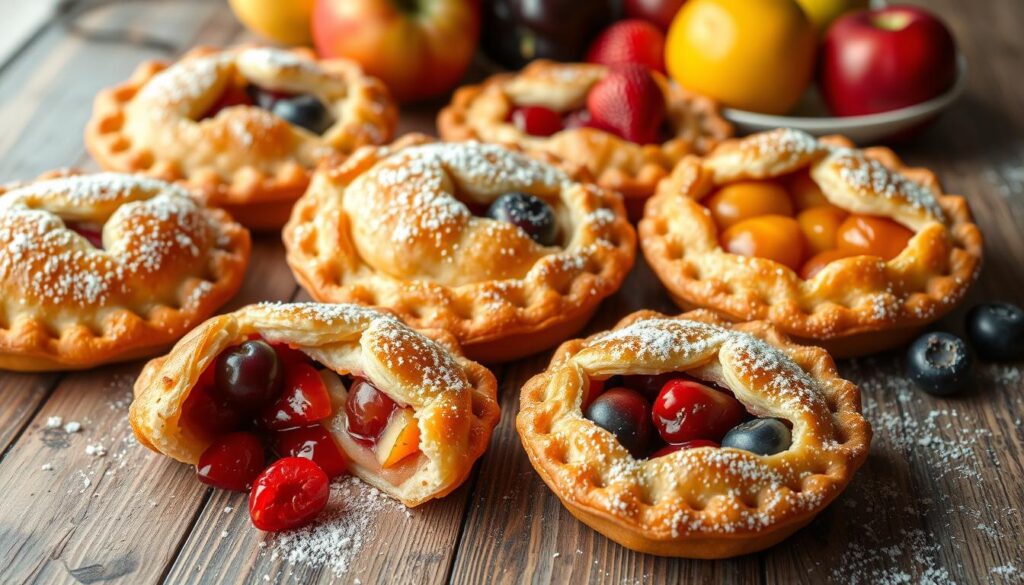Indulge in a classic fried pie dessert with this easy-to-follow recipe. Create a delightful and satisfying treat at home.
Table of Contents
Fried pies are a classic dessert that can be made with a variety of fillings, making them a great option for anyone looking for a new dessert recipe to try. Pie making is an art that requires some practice, but with the right ingredients and techniques, anyone can create delicious fried pies. When it comes to dessert recipes, fried pies are a great choice because they are easy to make and can be customized with different fillings.
Fried pies have a rich history and cultural significance in America, and they are a popular treat at many festivals and fairs. With the right ingredients and equipment, anyone can make delicious fried pies at home. Whether you’re a beginner or an experienced baker, this easy fried pie recipe is a great place to start. With its simple ingredients and step-by-step instructions, you’ll be making delicious fried pies in no time, and exploring the world of pie making will become your new favorite hobby.
The History and Heritage of Fried Pies
Fried pies have a rich history that spans centuries, with their origins dating back to traditional European pastry-making techniques. The art of creating these delicious treats has been passed down through generations, with various regional variations emerging over time. By mastering essential baking tips and cooking techniques, home cooks can create their own unique fried pie recipes.
The cultural significance of fried pies across America is evident in their popularity at family gatherings, festivals, and roadside eateries. To appreciate the evolution of fried pie making, it’s essential to explore the different ingredients, fillings, and cooking methods used in various parts of the country. Some popular fillings include fruit, nuts, and chocolate, which can be combined in countless ways to create unique flavor profiles.
Origins of Traditional Fried Pies
Traditional fried pies originated in Europe, where pastry-making was a highly respected craft. The first fried pies were made with simple ingredients like flour, water, and lard, which were readily available to peasants and nobility alike. As European settlers arrived in America, they brought their pastry-making traditions with them, adapting to new ingredients and cooking techniques.
Cultural Significance Across America
Fried pies have become an integral part of American cuisine, with different regions developing their own unique variations. From the sweet potato pies of the South to the apple pies of New England, each region has its own specialty. By experimenting with various baking tips and cooking techniques, home cooks can create their own regional specialties.
Evolution of Fried Pie Making
Over time, fried pie making has evolved to incorporate new ingredients, fillings, and cooking methods. The introduction of new spices, nuts, and fruits has expanded the possibilities for fried pie fillings, while advances in cooking technology have made it easier to achieve the perfect crust. By combining traditional baking tips with modern cooking techniques, home cooks can create innovative and delicious fried pie recipes.
| Region | Specialty Filling | Cooking Method |
|---|---|---|
| South | Sweet Potato | Deep-Fried |
| New England | Apple | Baked |
| Midwest | Pumpkin | Pan-Fried |
Essential Ingredients for Perfect Fried Pies
To make perfect fried pies, it’s crucial to use high-quality ingredients, including the right type of pastry dough and delicious filling ideas. The pastry dough should be flaky and tender, while the filling should be sweet and flavorful. Some popular filling ideas include fruit, such as apples or cherries, and creamy fillings, like custard or chocolate.
When choosing a pastry dough, consider using a homemade or store-bought dough that is made with simple ingredients, such as flour, butter, and water. For filling ideas, think about using seasonal fruits or trying out unique flavor combinations, like strawberry and rhubarb or peach and cream. The key is to find the perfect balance between the pastry dough and the filling, so that each bite is a delightful combination of textures and flavors.
- Choose a pastry dough that is easy to work with and can hold its shape when filled and fried.
- Consider using a variety of filling ideas to cater to different tastes and dietary preferences.
- Don’t be afraid to experiment with new and unique flavor combinations to create your own signature fried pie recipe.
By following these tips and using high-quality ingredients, you’ll be well on your way to creating perfect fried pies that are sure to impress your friends and family.
Kitchen Tools and Equipment Needed
To make delicious fried pies, it’s essential to have the right kitchen tools and equipment. Having the necessary kitchen tools can make the process more efficient and enjoyable. A well-stocked kitchen with the right equipment can help to ensure that your fried pies turn out perfectly.
Some essential utensils include rolling pins, pastry brushes, and cutting tools. These kitchen tools will help you to prepare and shape the dough, as well as cut out the perfect pie shapes. Additionally, having a good quality frying pan or deep fryer is crucial for achieving the perfect crispy crust.
Essential Utensils
- Rolling pins for rolling out the dough
- Pastry brushes for applying egg wash or melted butter
- Cutting tools, such as pastry cutters or knives, for cutting out pie shapes
Optional Equipment for Convenience
While not essential, some optional equipment can make the process of making fried pies more convenient. Stand mixers and food processors can help to speed up the process of making the dough, while oven mitts and trivets can provide protection when handling hot pans.
Safety Equipment Recommendations
Safety should always be a top priority when working in the kitchen. Oven mitts and trivets can help to prevent burns, while a fire extinguisher can provide peace of mind in case of an emergency. By having the right kitchen tools and equipment, you can ensure that your fried pie making experience is both enjoyable and safe.
| Kitchen Tool | Description |
|---|---|
| Rolling Pin | Used to roll out the dough to the perfect thickness |
| Pastry Brush | Used to apply egg wash or melted butter to the dough |
| Frying Pan | Used to fry the pies to a crispy golden brown |
Creating the Perfect Fried Pie Dough
When it comes to pie making, the dough is a crucial component. To create the perfect fried pie dough, it’s essential to use the right type of flour. All-purpose flour is a popular choice, but some baking tips suggest using a combination of all-purpose and pastry flour for a more tender crust.
A key element in creating the perfect dough is the role of fat. Using the right amount of fat, such as butter or lard, will help to create a flaky and tender crust. Here are some baking tips to keep in mind:
- Use cold ingredients to help the dough come together
- Don’t overmix the dough, as this can lead to a tough crust
- Use the right amount of liquid to create a smooth and pliable dough
Another important aspect of pie making is the technique used to mix and roll out the dough. Using a gentle touch and the right amount of pressure will help to create a smooth and even crust. Here’s a simple recipe to get you started:
| Ingredient | Quantity |
|---|---|
| All-purpose flour | 2 cups |
| Pastry flour | 1 cup |
| Cold butter | 1/2 cup |
| Ice-cold water | 1/4 cup |
By following these baking tips and using the right ingredients, you’ll be well on your way to creating the perfect fried pie dough. Remember to always use fresh and high-quality ingredients, and don’t be afraid to experiment with different flavors and fillings to create your own unique pie making creations.

Classic Fried Pie Recipe: Step-by-Step Guide
To create a delicious fried pie, it’s essential to master various cooking techniques, including preparing the filling and rolling out the dough. Filling ideas can range from sweet to savory, allowing for endless possibilities. When it comes to cooking techniques, the key is to achieve the perfect balance between the crust and the filling.
Some popular filling ideas include fruit, such as apples or cherries, and creamy fillings like custard or chocolate. The choice of filling will depend on personal preference and the desired flavor profile. By experimenting with different filling ideas and cooking techniques, you can create a unique and mouth-watering fried pie.
Here are some tips for preparing the filling and rolling out the dough:
- Choose a filling that complements the flavor of the crust
- Roll out the dough to the desired thickness
- Use a gentle touch when handling the dough to avoid tearing
By following these tips and mastering various cooking techniques, you can create a delicious fried pie that’s sure to impress.
| Filling Ideas | Cooking Techniques |
|---|---|
| Fruit, custard, chocolate | Rolling out the dough, frying the pie |
With practice and patience, you can become a master of fried pie making, experimenting with new filling ideas and cooking techniques to create the perfect treat.
Popular Filling Variations and Combinations
Fried pies can be filled with a variety of delicious ingredients, including fruit fillings and cream fillings. These fillings can be used separately or combined to create unique and tasty flavor profiles.
Some popular fruit fillings include apple, cherry, and blueberry. These fillings are often made with fresh or frozen fruit, sugar, and spices, and can be used to create sweet and tangy flavor combinations. Cream fillings, on the other hand, are made with ingredients like vanilla, chocolate, and nuts, and can add a rich and creamy texture to fried pies.
Fruit-Based Fillings
Fruit-based fillings are a great option for those looking for a sweet and tangy flavor. Some popular fruit fillings include:
- Apple filling, made with fresh apples, sugar, and cinnamon
- Cherry filling, made with fresh cherries, sugar, and almond extract
- Blueberry filling, made with fresh blueberries, sugar, and lemon zest
Cream and Custard Options
Cream and custard fillings are a great option for those looking for a rich and creamy texture. Some popular cream and custard fillings include:
- Vanilla cream filling, made with vanilla extract, sugar, and heavy cream
- Chocolate cream filling, made with cocoa powder, sugar, and heavy cream
- Caramel custard filling, made with caramel sauce, sugar, and eggs
These fillings can be used to create a variety of delicious flavor combinations, such as apple and cherry, or vanilla and chocolate. The possibilities are endless, and the choice of filling will depend on personal preference and the desired flavor profile.
| Filling Type | Ingredients | Flavor Profile |
|---|---|---|
| Fruit Fillings | Fresh or frozen fruit, sugar, spices | Sweet and tangy |
| Cream Fillings | Vanilla, chocolate, nuts, heavy cream | Rich and creamy |
Troubleshooting Common Fried Pie Problems
When making fried pies, several common problems can arise, requiring some troubleshooting to resolve. Troubleshooting these issues is crucial to achieve the perfect fried pie. One of the most common problems is dough that is too sticky or too dry. To fix this, adjust the amount of water or flour in the dough until it reaches the right consistency.
Another issue is fillings that are too runny or too thick. To address this, adjust the amount of liquid or thickening agent in the filling. For example, if the filling is too runny, add a little more cornstarch or flour to thicken it. If it’s too thick, add a little more liquid, such as water or juice.
- Dough too sticky: add more flour
- Dough too dry: add more water
- Filling too runny: add more cornstarch or flour
- Filling too thick: add more liquid
By following these troubleshooting tips, you can overcome common problems and achieve the perfect fried pie. Remember to always use fresh ingredients and follow the recipe carefully to minimize the risk of errors. With a little practice and patience, you’ll be making delicious fried pies like a pro, and troubleshooting will become second nature.
| Problem | Solution |
|---|---|
| Dough too sticky | Add more flour |
| Dough too dry | Add more water |
| Filling too runny | Add more cornstarch or flour |
| Filling too thick | Add more liquid |
Storage and Reheating Guidelines
To keep your fried pies fresh for a longer period, it’s essential to follow proper storage tips. Refrigeration and freezing are two common methods used to store fried pies. When refrigerating, make sure to place the pies in an airtight container to prevent moisture from entering. Freezing, on the other hand, requires wrapping the pies tightly in plastic wrap or aluminum foil to prevent freezer burn.
When it comes to reheating methods, there are a few options available. You can reheat your fried pies in the oven or microwave. For oven reheating, preheat the oven to 350°F (180°C) and bake the pies for 10-15 minutes, or until they’re crispy and golden brown. For microwave reheating, heat the pies on high for 20-30 seconds, or until they’re warm and crispy.
Proper Storage Methods
- Refrigerate pies in an airtight container
- Freeze pies by wrapping them tightly in plastic wrap or aluminum foil
- Label and date the storage container for easy identification
Reheating Instructions
- Preheat the oven to 350°F (180°C)
- Bake the pies for 10-15 minutes, or until crispy and golden brown
- Heat the pies in the microwave on high for 20-30 seconds, or until warm and crispy

Shelf Life Tips
Fried pies can be stored for up to 3 days in the refrigerator and up to 2 months in the freezer. When storing, make sure to follow proper storage tips and reheating methods to ensure the pies remain fresh and crispy.
| Storage Method | Shelf Life |
|---|---|
| Refrigeration | Up to 3 days |
| Freezing | Up to 2 months |
Serving Suggestions and Accompaniments
Fried pies are a delicious dessert that can be served in a variety of ways, making them a great addition to any meal or gathering. When it comes to serving suggestions, the possibilities are endless. Consider serving your fried pies with a scoop of ice cream or a dollop of whipped cream for a sweet and indulgent treat.
In addition to traditional serving methods, fried pies can also be paired with a variety of accompaniments to enhance their flavor and texture. Some popular accompaniments include coffee, tea, or hot chocolate. You can also try pairing your fried pies with a side of fresh fruit or a sprinkle of powdered sugar for a lighter and more refreshing option.
Here are some ideas for serving and accompanying your fried pies:
- Serve with a scoop of your favorite ice cream flavor
- Pair with a hot cup of coffee or tea
- Offer with a side of fresh fruit, such as strawberries or blueberries
- Dust with powdered sugar for a sweet and elegant touch
By considering these serving suggestions and accompaniments, you can create a unique and delicious dessert experience that is sure to impress your friends and family. Whether you’re serving fried pies at a dinner party or just enjoying them as a sweet treat, there are many ways to enhance their flavor and presentation.
| Serving Suggestion | Accompaniment |
|---|---|
| Fried pie with ice cream | Whipped cream and sprinkles |
| Fried pie with coffee | Sugar and cream |
| Fried pie with fresh fruit | Powdered sugar and mint |
Health and Dietary Considerations
When it comes to enjoying fried pies, health considerations are crucial. Fried pies can be a part of a balanced diet if consumed in moderation. It’s essential to consider the nutritional information and dietary options available. A typical fried pie can range from 250 to 500 calories, depending on the filling and size.
For those with specific dietary needs, there are various modifications that can be made. Gluten-free and vegan options are becoming increasingly popular, and many recipes can be adapted to accommodate these requirements. Some popular dietary options include using alternative flours, such as almond or coconut flour, and substituting traditional fillings with fruit or nut-based alternatives.
Nutritional Information
A fried pie’s nutritional content can vary greatly depending on the ingredients used. On average, a fried pie can contain around 10-20g of fat, 30-40g of carbohydrates, and 5-10g of protein. It’s essential to consider these nutritional values when incorporating fried pies into your diet.
Dietary Modifications
For those with specific dietary requirements, there are several modifications that can be made to traditional fried pie recipes. Some popular options include:
- Gluten-free crusts made with alternative flours
- Vegan fillings made with fruit or nuts
- Sugar-free fillings made with natural sweeteners
Portion Control Guidelines
To enjoy fried pies as part of a balanced diet, it’s crucial to practice portion control. A standard serving size is one small to medium-sized pie. It’s also essential to balance your diet with a variety of other foods, including fruits, vegetables, whole grains, and lean proteins.
By considering health considerations and exploring various dietary options, you can enjoy fried pies while maintaining a balanced diet. Remember to always check the nutritional information and ingredient list to ensure that your fried pie meets your dietary needs.
| Dietary Option | Nutritional Information | Portion Control |
|---|---|---|
| Gluten-free | 10-20g fat, 30-40g carbohydrates, 5-10g protein | 1 small to medium-sized pie |
| Vegan | 10-20g fat, 30-40g carbohydrates, 5-10g protein | 1 small to medium-sized pie |
Conclusion
As we conclude our journey through the world of homemade fried pies, it’s clear that these flavorful treats hold a special place in American culinary heritage. From their humble origins to the endless flavor possibilities, fried pies have become a beloved dessert that brings people together.
By mastering the techniques outlined in this guide, you can create mouthwatering fried pies right in your own kitchen. Whether you opt for classic fruit fillings or experiment with creative combinations, the key is to use high-quality ingredients and follow proper frying methods.
As you continue your fried pie journey, remember to have fun and get creative. Explore seasonal flavors, experiment with different dough recipes, and find ways to personalize your creations. The conclusion of this article is just the final thoughts on your path to becoming a fried pie connoisseur.



